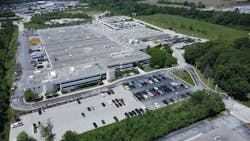Wacker Neuson ‘Strategy 2030’ has N.A. focus
Following a successful fiscal 2022, the Wacker Neuson Group has unveiled its new corporate strategy. With this "Strategy 2030,” the company expects to continue its growth trajectory of recent years and significantly increase revenue and earnings in the long term.
Content provided by Wacker Neuson
The company aims at further expansion in the Americas region. Here, Wacker Neuson is aiming to significantly increase the region’s percentage share of Group revenue by 2030. The focus here is on creating a balanced sales channel mix between independent dealers, authorized dealers, and key accounts, while simultaneously optimizing the product and production portfolio.
In addition, the cooperation with John Deere in particular, with an OEM supply contract for mini and compact excavators, is expected to contribute to growth in the region once the ramp-up has been completed.
Read also: Wacker Neuson, John Deere partner on excavators
The percentage of Group revenue accounted for by the Asia-Pacific region is also expected to increase significantly by 2030. Here, the company will continue on its already successful path and expand its product range adapted to the region. Despite intense competition in the local Chinese market itself, the Wacker Neuson Group benefits from the attractive cost structures of its production site in China. With the Chinese plant acting as a production hub for the region, the company is clearly benefiting from rising demand in technically less regulated markets such as Africa or Australia.
Wacker Neuson sales targets
Group sales are expected to grow to 4 billion euros by 2030, compared to 2.25 billion euros in the previous fiscal year 2022. In parallel, the EBIT margin is expected to increase from 9.0 percent in 2022 to sustainably over 11 percent in the coming years. The targeted net working capital ratio of less than 30 percent strikes the right balance between operational resilience, taking into account difficult global supply chains, and generating free cash flow for sustainable growth.
“With our Strategy 2030, we are showing our investors how the Wacker Neuson Group shall grow in the coming years. It is based on ten strategic levers that also make the individual steps in the implementation of our strategy clearly comprehensible,” said Dr. Karl Tragl, CEO, in a statement. “This is how we are continuing to write our growth story, even in times of economic and political uncertainty. A high degree of innovativeness, our strong global presence and our broad-based customer structures give us the backing we need to achieve this. At the same time, our special product mix makes the Wacker Neuson Group less vulnerable to economic cycles in our target industries.”
The prospective expansion of revenue to EUR 4 billion in the long term is based on current market scenarios and a compound annual growth rate (CAGR) of 8 percent, which corresponds to the average growth of the company in recent years. Only organic growth drivers were included in the strategic scenarios. However, the company considers itself well positioned for attractive acquisition opportunities in the coming years and will take advantage of these at any time. The outlined increase in EBIT margin to over 11 percent is based, among other things, on the successful continuation of efficiency measures that have already led to a tangible improvement in earnings margins in recent quarters. Accordingly, the Executive Board is confident that it will be able to establish the targeted EBIT margin level of 11 percent before 2030.
In order to clearly structure the individual steps in the implementation of the new corporate strategy, Strategy 2030 is based on ten strategic levers. They describe milestones of the growth prospects resulting from the market position, the innovative product portfolio, regional expansion opportunities, digitalization, and efficiency gains, but also from aspects of sustainability and the retention and further development of employees.
These 10 levers of organic growth in the coming years include, for example, expanding the market position as a leading company in the field of soil and concrete compaction (Light Equipment). By 2025, the main aim is to further expand market share in rammers, plates, and trench rollers as well as in concrete compaction with internal and external vibrators. To achieve this, the Wacker Neuson Group is focusing on organic growth initiatives, the launch of new products, growth in the spare parts market, reducing production costs and gaining special customer benefits by aiming to establish a common standard for batteries in construction site operations with other major manufacturers.
Another lever is the “zero emission” product range, where the Wacker Neuson Group aims to expand its pioneering role in the development of zero-emission construction equipment to a triple-digit million figure by 2025. Furthermore, revenue generated by the Aftermarket & Services segment is set to increase significantly. In this context, growth in the spare parts and services business is to contribute to increasing the Group's overall profitability. This improved penetration of the aftermarket is to be secured through tailored measures in each individual relevant business unit.
At the same time, the Wacker Neuson Group believes it is well positioned to achieve further efficiency gains in production. For example, a new, state-of-the-art steel plant was opened at the production site in Serbia in 2022 as the first expansion step and the next stage of expansion has already begun. Furthermore, the business units are increasingly succeeding in coping with the problems of the current economic environment.
An integral part of the Strategy 2030 is also the company's sustainability strategy. To date, the Wacker Neuson Group has already taken numerous steps to significantly reduce the company's carbon footprint. By 2025, CO2 emissions (Scope 1 & 2) are to be cut by around 50 percent compared with 2019, for example by switching to green electricity, reducing internal fleet emissions, and installing photovoltaic systems.
